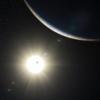

| Visitors Now: | |
| Total Visits: | |
| Total Stories: |

By Extinction Protocol: 2012 Earthchanges and News Event (Reporter)
Contributor profile | More stories
Contributor profile | More stories
| Story Views | |
| Now: | |
| Last Hour: | |
| Last 24 Hours: | |
| Total: | |
Scientists record the brightest explosion ever seen in space
Thursday, May 9, 2013 4:57
% of readers think this story is Fact. Add your two cents.
 May 9, 2013 – SPACE - A star being ripped to shreds in a violent supernova is one of the most powerful explosions in the universe. The largest supernovae can produce gamma-ray bursts: a tightly concentrated lance of light that streams out into space. Gamma-ray bursts, says NASA, “are the most luminous and mysterious explosions in the universe.” The blasts emit surges of gamma rays — the most powerful form of light — as well as X-rays, and they produce afterglows that can be observed at optical and radio energies. Two weeks ago, says NASA, astronomers saw the longest and brightest gamma-ray burst ever detected. It was the biggest shot of energy we’ve ever seen, streaming from the universe’s most powerful class of explosions. NASA: “We have waited a long time for a gamma-ray burst this shockingly, eye-wateringly bright,” said Julie McEnery, project scientist for the Fermi Gamma-ray Space Telescope at NASA’s Goddard Space Flight Center in Greenbelt, Md. “The event, labeled GRB 130427A, was the most energetic gamma-ray burst yet seen, and also had the longest duration,” says Matthew Francis for Ars Technica. “The output from GRB 130427A was visible in gamma ray light for nearly half a day, while typical GRBs fade within a matter of minutes or hours.” There are a few different of classes of gamma-ray bursts in the world. Astrophysicists think that some—short gamma-ray bursts—form when two neutron stars merge and emit a pulse of energy. Huge ones like the one just detected are known as long gamma-ray bursts, and they form when huge stars collapse, often leading to the formation of a black hole. Gamma-ray bursts focus their energy in a tightly-concentrated spire of energy. A few years ago, says Wired, researchers calculated what would happen if a gamma-ray burst went off nearby, and was pointed at the Earth. Steve Thorsett of Princeton University has calculated the consequences if such a merger were to take place within 3,500 light-years of Earth, with its energy aimed at the solar system. The blast would bathe Earth in the equivalent of 300,000 megatons of TNT, 30 times the world’s nuclear weaponry, with the gamma-ray and X-ray radiation stripping Earth of its ozone layer. While scientists cannot yet predict with any precision which nearby stars will go supernova, the merger of neutron star binaries is as predictable as any solar eclipse. Three such binary systems have been discovered, and one, PSR B1534+12, presently sits about 3,500 light-years away and will coalesce in a billion years. –Smithsonian
May 9, 2013 – SPACE - A star being ripped to shreds in a violent supernova is one of the most powerful explosions in the universe. The largest supernovae can produce gamma-ray bursts: a tightly concentrated lance of light that streams out into space. Gamma-ray bursts, says NASA, “are the most luminous and mysterious explosions in the universe.” The blasts emit surges of gamma rays — the most powerful form of light — as well as X-rays, and they produce afterglows that can be observed at optical and radio energies. Two weeks ago, says NASA, astronomers saw the longest and brightest gamma-ray burst ever detected. It was the biggest shot of energy we’ve ever seen, streaming from the universe’s most powerful class of explosions. NASA: “We have waited a long time for a gamma-ray burst this shockingly, eye-wateringly bright,” said Julie McEnery, project scientist for the Fermi Gamma-ray Space Telescope at NASA’s Goddard Space Flight Center in Greenbelt, Md. “The event, labeled GRB 130427A, was the most energetic gamma-ray burst yet seen, and also had the longest duration,” says Matthew Francis for Ars Technica. “The output from GRB 130427A was visible in gamma ray light for nearly half a day, while typical GRBs fade within a matter of minutes or hours.” There are a few different of classes of gamma-ray bursts in the world. Astrophysicists think that some—short gamma-ray bursts—form when two neutron stars merge and emit a pulse of energy. Huge ones like the one just detected are known as long gamma-ray bursts, and they form when huge stars collapse, often leading to the formation of a black hole. Gamma-ray bursts focus their energy in a tightly-concentrated spire of energy. A few years ago, says Wired, researchers calculated what would happen if a gamma-ray burst went off nearby, and was pointed at the Earth. Steve Thorsett of Princeton University has calculated the consequences if such a merger were to take place within 3,500 light-years of Earth, with its energy aimed at the solar system. The blast would bathe Earth in the equivalent of 300,000 megatons of TNT, 30 times the world’s nuclear weaponry, with the gamma-ray and X-ray radiation stripping Earth of its ozone layer. While scientists cannot yet predict with any precision which nearby stars will go supernova, the merger of neutron star binaries is as predictable as any solar eclipse. Three such binary systems have been discovered, and one, PSR B1534+12, presently sits about 3,500 light-years away and will coalesce in a billion years. –Smithsonian
Source:


